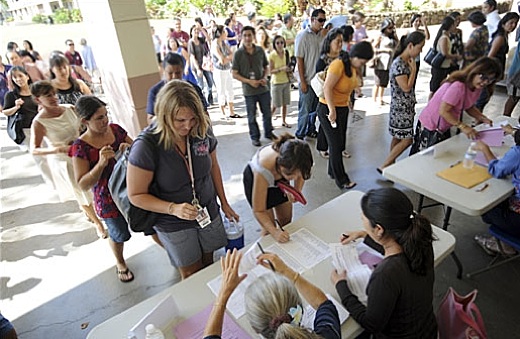 image above: Hawaii State Teachers Association members vote on contract.
http://www.edweek.org/login.html?source=http://www.edweek.org/ew/articles/2009/09/30/05hawaii.h29.html
image above: Hawaii State Teachers Association members vote on contract.
http://www.edweek.org/login.html?source=http://www.edweek.org/ew/articles/2009/09/30/05hawaii.h29.html
Editorial on 30 October 2009 in New York Times - http://www.nytimes.com/2009/10/31/opinion/31sat2.html
The economic crisis has forced every state to scramble to get its budget in balance. This has meant torturous efforts to preserve essential services and minimize the pain and damage from slashed spending and lost jobs. Every state has sacrificed. But Hawaii has sacrificed its own schoolchildren.
The 50th state, the only one with a single statewide school district, has just cut 17 days from the academic year, under a new labor contract with public school teachers that avoids layoffs in favor of pay cuts and furloughs, all to be taken on instructional days. Barring a court order or other intervention, there will be no classes on most Fridays for the rest of the school year, leaving 170,000 children in the lurch. Parents are furious that a state already lagging in academic achievement would willingly adopt the country’s shortest school year.
The teachers’ union, the school board, the Department of Education and Gov. Linda Lingle all share responsibility for the debacle; they all signed off on the new contract last month. Ms. Lingle issued a statement at the time praising it as being “in the best interest of teachers, our students and the general public.”
Parents don’t think so. Nor does the federal education secretary, Arne Duncan. In an op-ed article in The Honolulu Advertiser, he called it “inconceivable” that furlough Fridays were the best solution to school-budget woes and wondered why the state hadn’t used its federal stimulus money to save classroom days. (The state instead used the $105 million to cut its own contribution to education, which was legal but hardly admirable.)
Hawaii’s political leaders and school officials are now standing in a circle of blame, pointing at one another. The governor, who had ordered the Department of Education to cut its $1.8 billion budget by 14 percent, now says she had not expected the union to take its furlough days from instruction time. She said she regretted the settlement, even though her attorney general defended it in hearings over two federal lawsuits filed on behalf of parents and children trying to restore the school days.
As other states struggle to bolster education, to add classes and lengthen the school year, Hawaii is going in the wrong direction. What it needs are not apologies but open classrooms for the students whose futures are being mortgaged — especially the poor and disabled children and those in special education who are particularly vulnerable to lost instructional time. For now, they are learning a terrible lesson in how little their government and teachers think an education is worth.
No comments :
Post a Comment